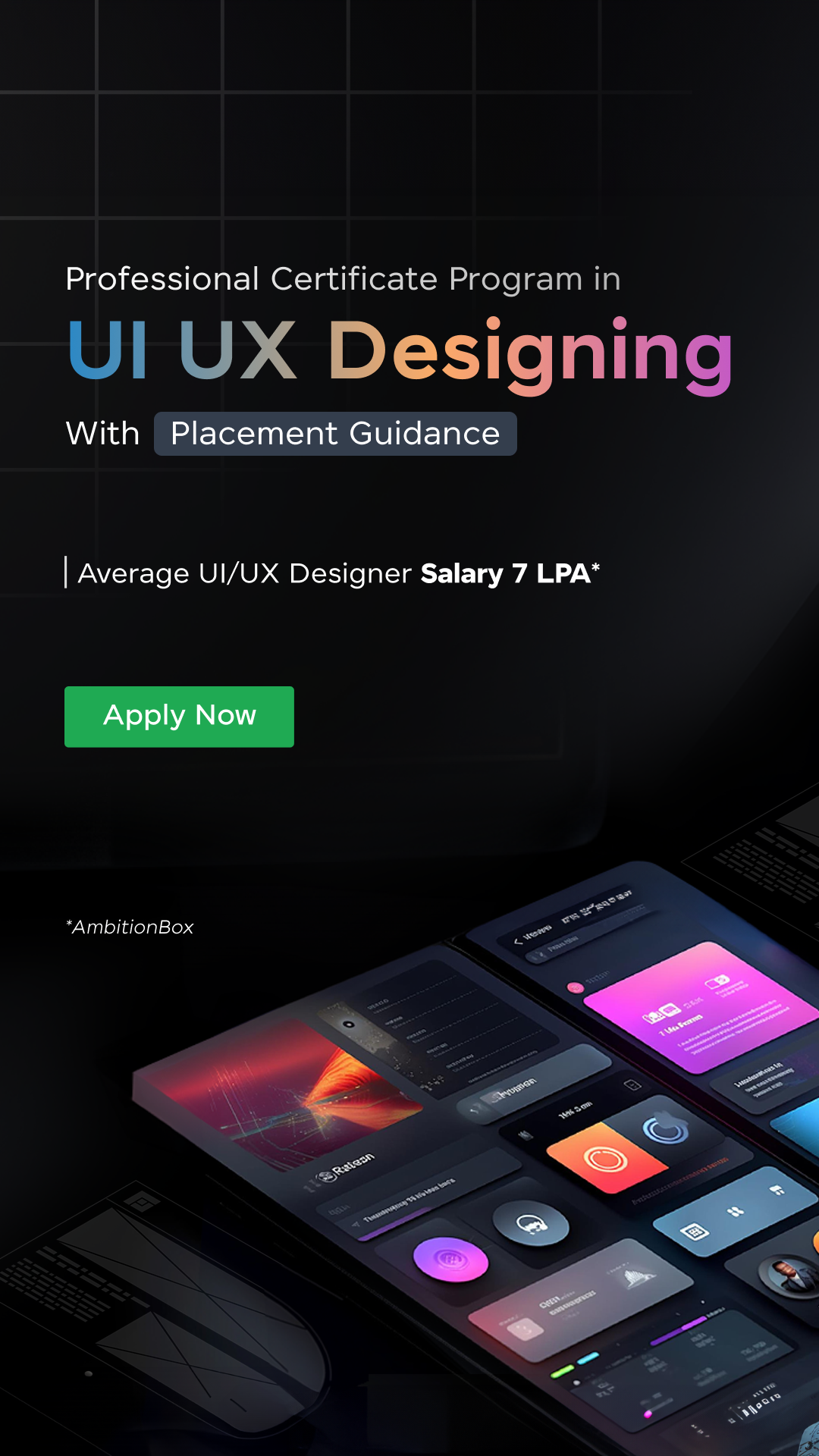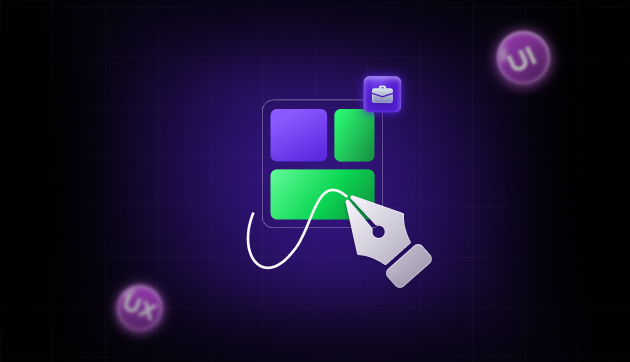![How to Become a UI/UX Designer in India [2024] 1 Post thumbnail](https://www.guvi.in/blog/wp-content/uploads/2023/08/UX-Designer-in-India.png)
How to Become a UI/UX Designer in India [2024]
Nov 26, 2024 6 Min Read 5900 Views
(Last Updated)
As we move to 2024, we all know that UI/UX designers have become the most demanding professionals and high-paying as well. Are you fascinated by the user experience of your favorite apps or websites like Netflix, Amazon, etc.? Are you someone with an eye for aesthetics, problem-solving, and human-centered innovation?
Then, It is high time, you learn UI/UX design & become a creator of the website that would join the above list. Yes, UI/UX is not complicated if you learn it the right way.
If you are still thinking about how to become a UI/UX designer? Look no further! We’ve got you covered. In this guide, we will explore the ways to become a UI/UX designer step by step, understanding the basics, exploring the pathway, and laying a strong foundation. Let’s get started.
Table of contents
- Understanding the role of UI/UX Designers
- What Does a UI/UX Designer Do?
- How to Become a UI/UX Designer: Step-by-Step Guide
- Understand the Role
- Learn Design Principles
- Learn User Experience
- Get Familiar with Design Tools
- Sign up for Online Courses
- Work on Real-Time Projects
- Build Portfolio
- Grow your Network
- Improve Continuously
- Salary of UI/UX Designers
- Wrapping Up
- FAQs
- What skills are required to become a UI/UX designer?
- How do I start learning UI/UX design?
- Do I need to be good at drawing to become a UI/UX designer?
- Do I need a degree to become a UI/UX designer?
- How to become a UI/UX designer with no experience?
Understanding the role of UI/UX Designers
Before we begin with this UI/UX designer roadmap journey, you need to know their role.
A UI/UX (User Interface/User Experience) designer is a professional who specializes in creating user-friendly and visually appealing digital products, such as websites, mobile apps, software, and other interactive applications. The main goal of a UI/UX designer is to enhance the overall experience of users when interacting with a product, ensuring that it is 100% intuitive, efficient, and enjoyable to use.
![How to Become a UI/UX Designer in India [2024] 2 ui ux designing](https://www.guvi.in/blog/wp-content/uploads/2023/10/designing-ui-ux-1200x675.webp)
Now, let’s read about who is a UI designer and UX designer.
UI Designer: UI design (User Interface design) focuses on the visual and interactive elements of a product. This involves designing the layout, colors, typography, icons, and other visual elements to create an aesthetically pleasing and consistent user interface.
UX Designer: UX design (User Experience design) focuses on understanding the needs and preferences of users to improve the usability and overall experience of the product. UX designers conduct user research, create user personas, design user flows, wireframes, and prototypes, and conduct usability testing to gather feedback and iteratively improve the product.
As we proceed to the next phase, make sure you understand the fundamentals of UI/UX, which includes heuristic analysis, journey maps, testing, etc. If you want to explore more about it, join GUVI’s UI/UX Course with Placement Assistance. You’ll also learn about the tools used in UI/UX which are AdobeXD, Illustrator, Photoshop, Figma, and many more. Build some amazing real-time projects to get hands-on experience.
What Does a UI/UX Designer Do?
Now, let’s understand what a UI/UX designer does. A day in the life of a UI/UX designer might include various tasks to bring out interactive applications and usable interfaces. Here is a more detailed step-by-step breakdown of what UI/UX designers do and their role in the product development process.
1. User Research: The process of conducting in-depth research to understand the target users, their needs, preferences, and pain points. This involves gathering insights through interviews, surveys, and data analysis.
![How to Become a UI/UX Designer in India [2024] 3 user research](https://www.guvi.in/blog/wp-content/uploads/2023/08/user-research-1200x675.webp)
2. User Personas: Creation of user personas that represent typical users, including their goals, behaviors, and characteristics. These personas help guide design decisions to meet the specific needs of different user groups.
3. Information Architecture: Organizing and structuring the product’s content and features in a way that allows users to navigate and find information easily.
4. Wireframing: The process of designing low-fidelity wireframes that outline the layout and structure of the user interface. Wireframes serve as a blueprint for the design, focusing on functionality rather than visual elements.
![How to Become a UI/UX Designer in India [2024] 4 Wireframing - How to become a UI/UX designer](https://www.guvi.in/blog/wp-content/uploads/2023/08/UI-design.jpg)
Image: Pexels
5. Prototyping: The construction of interactive prototypes that simulate the user interface and allow for testing and validation of design concepts. Prototypes help gather user feedback and identify potential issues early in the design process.
6. Interaction Design: The means of defining how users will interact with the product, including the behavior of buttons, animations, transitions, and other interactive elements.
Also, it is very important to know more about the skills required to become a UI/UX designer as you can’t step in without knowing about the things that you need foremost.
How to Become a UI/UX Designer: Step-by-Step Guide
Learning design principles, gaining practical experience, and building a strong portfolio to showcase your skills are all important stepping stones to becoming a UI/UX designer. Here’s a 10-step guide on how to become a UI/UX designer the right way:
![How to Become a UI/UX Designer in India [2024] 5 How to become a UI/UX designer](https://www.guvi.in/blog/wp-content/uploads/2023/08/uiux-design.jpg)
1. Understand the Role
Understanding the role of a UI/UX designer is the foundation upon which you build your career. It guides your learning, shapes your portfolio, and influences your interactions with colleagues and clients. It allows you to make an informed decision about whether UI/UX design aligns with your interests, strengths, and career goals.
A clear understanding of the role helps you identify the most relevant resources, courses, and learning opportunities. You’ll be able to tailor your learning path to match the specific skills and knowledge needed.
2. Learn Design Principles
Learning design principles is essential for anyone aspiring to become a successful UI/UX designer. Design principles encompass various fundamental concepts that guide the creation of visually appealing and effective designs:
- Color Theory: It is the theory of understanding how colors evoke emotions and create visual harmony
- Typography: It is the theory of choosing appropriate fonts and layouts for readability and aesthetics
- Layout and Composition: It is the theory of arranging elements on a screen to create balance and hierarchy
- Usability: It is the theory of ensuring designs are intuitive and user-friendly.
By mastering these principles, designers can create engaging and user-centric digital products that effectively communicate information and provide a delightful user experience.
3. Learn User Experience
Learning User Experience (UX) is a crucial aspect of becoming a UI/UX designer. Studying UX involves conducting user research through interviews, surveys, and data analysis to gain insights into user preferences and pain points. They should create user personas, which represent typical users and guide design decisions. UX designers should also develop user flows and wireframes to plan the product’s structure and interaction.
Prototyping and usability testing are essential steps to gather feedback and validate design choices. Through an iterative process, UX designers will continuously refine the product to ensure it meets user needs effectively and delivers a seamless and satisfying experience.
4. Get Familiar with Design Tools
Acquiring design tools is essential for UI/UX designers to bring their creative ideas to life. Design tools are software applications that facilitate the creation of user interfaces, prototypes, and other design assets.
Popular design tools in the industry include Figma, Sketch, and more. These tools offer a range of functionalities, such as creating vector graphics, designing interactive prototypes, collaborating with team members, and ensuring design consistency across various devices and platforms.
By mastering tools like InVision, you as a UI/UX designer can efficiently design, iterate, and communicate your ideas, enabling you to create visually appealing and user-friendly digital products that meet both business objectives and user needs.
5. Sign up for Online Courses
Taking online courses is a valuable step for aspiring UI/UX designers to gain structured learning and deepen their knowledge of design principles and practices. These Online Courses provide a structured curriculum that covers essential UI/UX design principles, tools, and techniques.
These courses are often taught by industry experts and cover essential aspects such as user research, prototyping, interaction design, and usability testing. Completing a reputable course can enhance your credibility as a UI/UX designer, especially if you’re transitioning from another field or starting from scratch.
6. Work on Real-Time Projects
Working on real-life projects is a crucial step for UI/UX designers to gain practical experience and apply their knowledge to real-world design challenges. Real-life UI/UX projects provide practical experience, skill development, and a deeper understanding of the challenges and nuances of UI/UX design.
By engaging in personal projects, such as redesigning websites, creating mobile app concepts, or designing user interfaces for specific industries, designers can hone their skills and experiment with different design approaches.
Projects allow designers to tackle various problems, consider user needs, and iterate on their designs. Additionally, personal projects provide an opportunity to build a diverse portfolio that showcases a range of design styles and problem-solving abilities, which is vital for attracting potential employers or clients.
Through hands-on project work, UI/UX designers can refine their craft, discover their design preferences, and build the confidence needed to tackle complex design tasks in their professional careers.
7. Build Portfolio
A portfolio is a curated collection of their best design work, including UI designs, UX case studies, prototypes, and other relevant projects. It demonstrates their design process, problem-solving abilities, and the ability to create user-centered solutions. A well-organized and visually appealing portfolio helps designers stand out to potential employers or clients, providing a tangible representation of their expertise and creativity.
Regularly updating the portfolio with new projects and iterating on existing ones allows designers to track their progress and growth over time, making it an indispensable tool for networking and securing job opportunities in the competitive design industry.
8. Grow your Network
Networking and connecting with other professionals in the design industry is a vital aspect of a UI/UX designer’s career growth. By attending design meetups, and conferences, or joining online design communities, designers can build relationships with like-minded individuals, industry experts, and potential collaborators.
Networking provides opportunities to exchange knowledge, share experiences, and stay updated with the latest trends and innovations in the field. Engaging in discussions, collaborating on projects, and seeking mentorship from seasoned designers can offer valuable insights, broaden perspectives, and foster personal and professional growth.
Moreover, networking opens doors to job opportunities, freelance gigs, and referrals, making it an essential tool for advancing one’s career and remaining connected to the dynamic and supportive design community.
9. Improve Continuously
Continuously improving is a fundamental principle for UI/UX designers to stay relevant and excel in their field. It involves a commitment to lifelong learning, seeking feedback, and actively seeking growth opportunities.
Designers should stay curious, and explore new design trends, emerging technologies, and industry best practices. Embracing feedback from peers, clients, and users allows designers to identify areas for improvement and refine their design skills. By adopting an iterative approach, designers can continuously iterate on their work, learning from each iteration and striving for better solutions.
Continuous improvement fosters adaptability, creativity, and the ability to solve complex design challenges effectively, ensuring that designers stay at the forefront of the rapidly evolving UI/UX design landscape and remain successful in their careers.
Salary of UI/UX Designers
The salary for UI/UX Designers in India can vary based on experience, location, company size, and industry. INDIA’S entry-level UI/UX Designers can expect an average annual salary ranging from ₹3,00,000 to ₹5,00,000. As designers gain more experience and expertise, their salaries tend to increase.
The data given below is as per AmbitionBox:
- For mid-level UI/UX Designers with 3-5 years of experience – ₹6,00,000 to ₹10,00,000.
- Experienced UI/UX Designers with 5+ years of experience – upwards of ₹12,00,000 per year or more
If you are looking for a complete, expert-led UI/UX Design Program, Sign up for GUVI’s Certified Online UI/UX Course with Job Placement Assistance. By enrolling in this course, you will enjoy flexible live online classes with unlimited lifetime access to the course content. This course also allows you to work on real-life recreation projects and gain practical skills.
Wrapping Up
Through this step-by-step guide on how to become a UI/UX designer, you can embark on a design career path with confidence. A commitment to continuous improvement is very important as it ensures that UI/UX designers stay adaptable and innovative in an ever-evolving field.
In your journey of following a UI/UX designer roadmap, remember that patience, persistence, and a passion for creating meaningful user experiences are your strongest allies. As you master the art of crafting intuitive interfaces and enhancing user journeys, you’ll find yourself at the forefront of shaping digital landscapes that enrich lives, businesses, and the digital world as a whole.
So, take that first step, embrace the challenges, and embark on the exciting adventure of becoming a skilled and empathetic UI/UX designer.
Now that you have read about how to become a UI/UX designer, it’s time to read about some of the best interview questions on UI/UX that you should know to get into top UI/UX companies.
FAQs
1. What skills are required to become a UI/UX designer?
As a UI/UX designer, you need skills in design principles, user research, wireframing, prototyping, interaction design, visual design, and usability testing. Soft skills like empathy, communication, and problem-solving are equally important.
2. How do I start learning UI/UX design?
Start by understanding the basics of design principles and user experience. Take online courses, read books, and practice on personal projects to apply your knowledge and skills.
3. Do I need to be good at drawing to become a UI/UX designer?
While having drawing skills can be helpful, they are not a prerequisite for UI/UX design. Many designers use digital tools and rely more on creativity, problem-solving, and communication skills.
4. Do I need a degree to become a UI/UX designer?
While a formal degree can be beneficial, it is not always necessary. Many successful UI/UX designers are self-taught and have gained their skills through online courses, workshops, and practical experience.
5. How to become a UI/UX designer with no experience?
Design knowledge is not a strict prerequisite to learning UI/UX. You can start by understanding the basics of design principles, user behavior, and the design process. Take online courses and practice by working on personal projects and redesigning existing websites or apps.
































Did you enjoy this article?